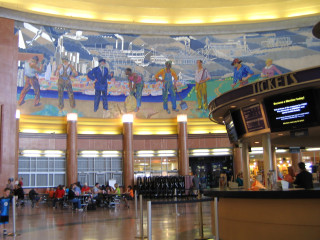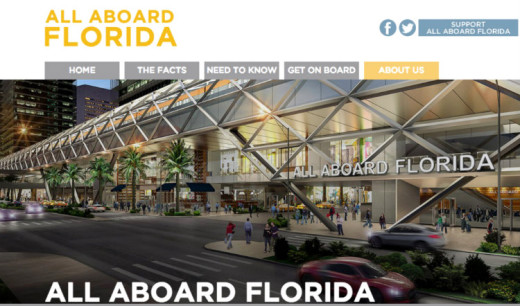Editor’s note: with this two-part article, we close out our “A Year in America” series. Our thanks to Deepa Sanyal, Kathy Trauger, and Anita Rasmussen for their contributions. All of their articles can be accessed through the sidebar on the left.
“… Now a train is often only a whistle heard far off on a sleepless night…the whistle announces a return and change to those who listen.” — John Stilgoe, Train Time: Railroads and the Imminent Reshaping of the United States Landscape
Washington’s Union Station, 1980. A great white mausoleum, echoing, empty, way station to the capital’s real sights. Forward to 2012 and Union station is, according to Travel & Leisure magazine, the third most visited tourist attraction in the country, with 36,500,000 visitors. 1

Likewise, Grand Central Terminal in New York City is America’s fifth most visited tourist destinations with 21,600,000 visitors a year. 2 People come to these beautifully restored Beaux Arts gems not just to catch a train, but to meet, eat, shop, and people watch in the stations’ grand arcades and concourses.
You never know what can happen in Grand Central Terminal — just watch the short video below.
Are we experiencing a resurgence of rail when trains linked farms, small towns, and cities catalyzing economic and geographic expansion — a time when train stations were the community’s crossroads, from the “… mundane to the momentous”? 3
Not quite yet, but demand for intercity passenger rail is growing. Amtrak has set a new ridership record with 2013 being its best year ever at 31.6 million passengers. John R. Stilgoe of Harvard University writes that the convergence of globalization, congestion, energy prices, and discomforts of air travel has driven a renewed interest in the role of rail for both passengers and freight. 4
Investing in Train Stations
Train stations represent an important part of many communities’ history, culture, and civic pride. … Since the late 1980s, cities and towns across the country have been investing in the renovation of their train stations.
An often overlooked lure of train travel is the historic train station. Train stations have served as romantically infused settings for novels, movies, and, for many of us, our own lives. Ed McMahon, a senior fellow at the Urban Land Institute, has pointed out that “public buildings and spaces create identity and a sense of place. They give communities something to remember and admire.” 5 Train stations, like courthouses and libraries, are at the heart of our communities.
Reiterating the sentiment, Amtrak describes historic train stations, perhaps a bit floridly, as architectural expressions of our growth as a nation, and of our core values and beliefs. 6 But certainly train stations represent an important part of many communities’ history, culture, and civic pride.

Since the late 1980s, cities and towns across the country have been investing in the renovation of their train stations, restoring and reinventing them as retail and entertainment destinations, convention centers, and museums — which in turn have sparked the revitalization of surrounding neighborhoods.
But, it should be said, these stations have often been more entertainment & retail destinations than transit hubs, with no significant uptick in ridership or trains.
Rail-Centric Projects
This may be changing, however, as in the past decade federal grants for rail station projects have focused on transportation uses. Active Amtrak railroad station projects are up, in both big-cities and smaller towns, reflecting the surge in passenger travel. Renovated train stations of the near future will function as integrated, intermodal transportation centers — while retaining entertainment and retail uses within and creating new urban neighborhoods without.
Two prime examples of the 21st century rail-centric stations are Washington, DC’s Union Station and Miami, Florida’s multi-modal station complex.
A new master plan for Washington’s Union Station will double its capacity for trains; provide improved infrastructure and operations; [and] triple passenger capacity to over 42 million by 2039.
A new master plan for Washington’s Union Station will double its capacity for trains; provide improved infrastructure and operations; triple passenger capacity to over 42 million by 2039; create critical station space on multiple levels; and serve as a transfer point for local and regional transit.
Real estate firm Akridge is slated to build Burnham Place, a three million square feet, multi-level office, residential, hotel, and retail facility, atop the existing platforms and rail yards, while creating new street networks, parks, public spaces, and neighborhood connections around Union station. 7
Nearly one thousand miles to the south, in Miami, Florida, a new rail complex is being planned to accommodate privately owned All Abroad Florida’s planned 32 daily high speed rail trains between Miami, Fort Lauderdale, and West Palm Beach. The Miami station complex will include a 400,000 sq. ft. transportation hub, along with nearly three million square feet of mixed use, transit oriented development — hotels, residences, retail, entertainment. 8

On empty lots around the station, developers will build two mammoth hotels, 400 apartments, a million square feet of retail, and a 600,000 square foot convention center. 9 The stations and their corollary real estate development are set to transform their surrounding neighborhoods into live-work-play urban environments and centers of economic prosperity.
The Nexus Between Rail Projects and Downtown Real Estate Development
Do real estate developments in and around train stations usurp land that could be used to build rail infrastructure — tracks, platforms, junctions — for more trains and passengers? Sean Jeans Gail, Vice President of the National Association of Passenger Rail thinks the rail/real estate land use nexus depends on location. 10 Presumably, where land is expensive, real estate is a more valuable investment than rail as it brings in more profits than train tickets.
Washington, DC’s Union Station is balancing rail versus real estate land use by allowing development within, below, and above the historic station footprint, while also constructing a new train shed, expanding the rail yard, re-activating multiple tracks, and leveraging the air rights for the Burnham Place transit-oriented development.
Continue to Part 2 of Rail Redux: What factors will drive a true rail resurgence? Plus a look at how passenger rail is developing in North Carolina’s Triangle region.
Deepa Sanyal is a Community Planning consultant and Training Professional. She provides professional services to local governments, communities, universities, and civic organizations seeking guidance on comprehensive planning, community assessments & revitalization, historic preservation, and cultural tourism. Deepa also advocates for and writes about sustainable development issues, and serves on the Chatham County Planning Board in her “Corner of the Triangle.”
Notes:
- America’s Most Visited Tourist Attractions (Travel & Leisure, Dec. 2012). ↩
- Ibid. ↩
- Janet Greenstein Potter, Great American Railroad Stations (Wiley, 1996). ↩
- John Stilgoe, Train Time: Railroads and the Imminent Reshaping of the United States Landscape (University of Virginia Press, 2007). ↩
- Edward McMahon, “Public Buildings Should Set the Standard” (Planning Commissioners Journal, January 2001). ↩
- Great American Stations: Helping Communities Discover & Develop the Economic Power of America’s Train Stations (Amtrak). ↩
- For more on Burnham Place, see pages on the Akridge and Amtrak web sites. ↩
- See All Aboard Florida Press Release, “All Aboard Florida Unveils Miami Station Designs by Skidmore, Owings & Merrill” (May 28, 2014). ↩
- See Henry Grabar, “The Triumphant Return of Private U.S. Passenger Rail” (CityLab, Jun 17, 2014). ↩
- Phone conversation between Deepa Sanyal and Sean Jeans Gail (July 8, 2014). ↩